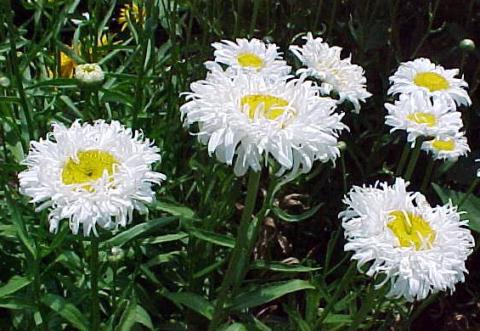Mary Ann Ryan
Adams County Master Gardener
 Summer gardening. What better
pastime! Nurturing and watching perennials grow and come into their own during the summer is one of my favorite parts of these warm months. Perennials take their turn at
being the "star of the show" when it comes to color. One of those spectacular and common perennials is the Shasta daisy.
Summer gardening. What better
pastime! Nurturing and watching perennials grow and come into their own during the summer is one of my favorite parts of these warm months. Perennials take their turn at
being the "star of the show" when it comes to color. One of those spectacular and common perennials is the Shasta daisy.
Scientifically speaking, Shasta daisy is known as Leucanthemum x superbum. The development of this perennial began in 1884 by a man named Luther
Burbank. Many crosses were made before the ever popular Shasta daisy existed.
Burbank loved the oxeye daisy. Seen in the fields of New England in his day – the mid to late 1800’s - as well as today, this plant has often been
considered a weed in turf and fields. Nonetheless, it was his favorite. But he thought that a perennial with a large flower that looked like the oxeye daisy would be
spectacular, hence the succession of crosses.
 The first cross was between the Oxeye daisy, Leucantheumum
vulgare, and English field daisy (Leucanthemum maximum). Burbank was not happy with the size of the daisy flower, so he selected the best of this cross and crossed it with L.
lacostre (Portuguese field daisy). Happy now with the size of the flower, but not the white coloration of this cross, he selected the best again and then crossed it with the
Japanese field daisy (Nipponanthemum nipponicum). Finally, he had a plant that he could be happy with, and called it the Shasta daisy (L. x superbum), naming it after Mt.
Shasta in California because of the snow caps on the mountain.
The first cross was between the Oxeye daisy, Leucantheumum
vulgare, and English field daisy (Leucanthemum maximum). Burbank was not happy with the size of the daisy flower, so he selected the best of this cross and crossed it with L.
lacostre (Portuguese field daisy). Happy now with the size of the flower, but not the white coloration of this cross, he selected the best again and then crossed it with the
Japanese field daisy (Nipponanthemum nipponicum). Finally, he had a plant that he could be happy with, and called it the Shasta daisy (L. x superbum), naming it after Mt.
Shasta in California because of the snow caps on the mountain.
Generally speaking, the Shasta daisy is very easy to grow. The flowers form individually on erect stems with white rays and yellow centers. They
typically bloom in June thru July. Depending on variety, the Shasta daisy can be as low as 12 inches or as tall as 4 feet. It likes to grow in full sun and well drained
soils. It makes a great cut flower and the butterflies love it. Typically, it should be divided about every three years, as the center of the plant may die out as it ages.
Since the birth of the Shasta daisy, many varieties have been developed. One of the most common and oldest of these varieties is ‘Alaska’ selected by
Burbank in the early 1900’s. This is a tall perennial, reaching as much as 3 feet high and a spread of 24 inches. The flowers get as large as 3 inches across. It requires no
staking, a real plus, and will re-bloom in August if deadheaded, which is the practice of cutting the old flowers off after they are finished blooming.
‘Becky’ is the tallest variety of Shasta daisy reaching 4 feet in height. This one will spread up to 3 feet across. One plant can make a spectacular
show in your garden once established.
Some of the shorter varieties include ‘Little Princess’ and ‘Snow Lady.’ Little Princess gets 12 to 15 inches tall and about that wide. It will bloom
through September if deadheaded. ‘Snow Lady’ gets about 8 to 12 inches high and wide. Its flowers have large yellow centers and shorter, white petals. The flowers are about 2
inches in diameter.
Two of the newer selections include ‘Crazy Daisy’ and ‘Broadway Lights.’ Both of these varieties are quite different than the ones mentioned so far.
‘Crazy Daisy’ has double blooms with white petals. Also different is its growing habit, which results in many flowers being produced on one stem. Most Shasta daisies have
only one flower per stem. ‘Crazy Daisy’ gets to be about 24 to 30" high and about 18" wide.
‘Broadway Lights’ is a daisy sporting pale yellow flowers that turn shades of butter to cream to pure white as they open and mature on the plant. It
reaches 24" tall and about that wide. Both of these selections are on my list of new perennials to try.
Keeping up with new varieties of Shasta daisy can be a full time job. Breeders throughout the world are always looking for bigger, brighter, larger,
better, or smaller, shorter, more compact varieties of plants. Watching for new introductions is always interesting. The fun thing about the Shasta daisy is knowing where it
came from and where it’s going. It is one of the longest living garden perennials ever "created," and still there is lots of breeding continuing in this century.
Read other articles on garden and landscape design